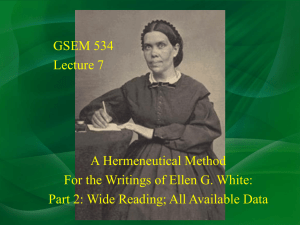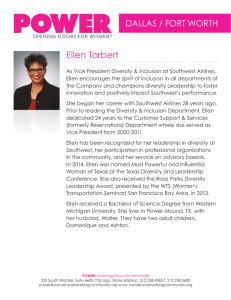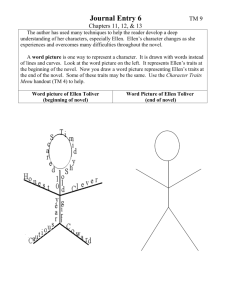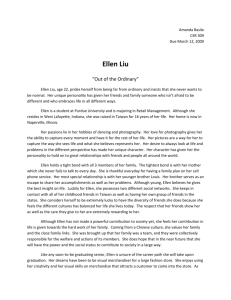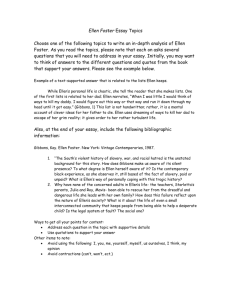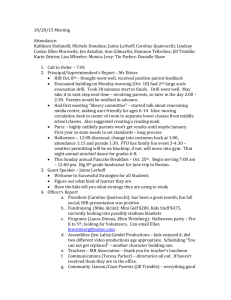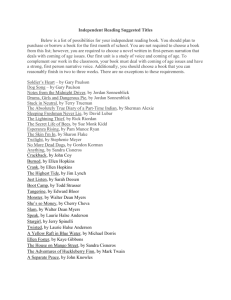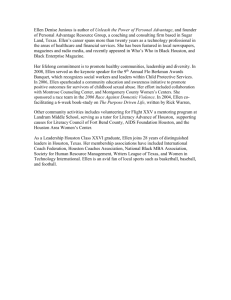slide presentation - Andrews University
advertisement
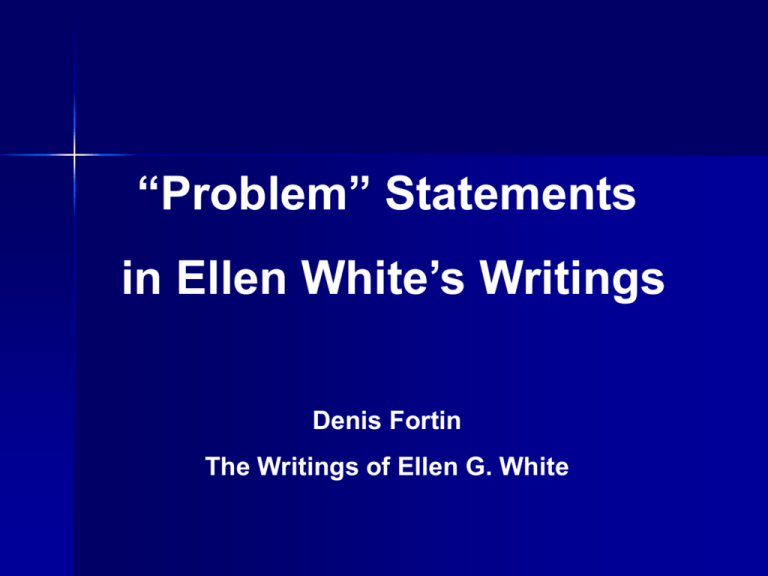
“Problem” Statements in Ellen White’s Writings Denis Fortin The Writings of Ellen G. White Statements on Diet and Lifestyle Ellen White’s statements on diet, nutrition, exercise, and preventive health measures have received unprecedented independent scientific verification and corroboration. Some Statements on Science Yet, in other areas dealing with scientific matters, there is generally widespread criticism regarding some of her views. These “problem” statements in science along with issues connected with literary borrowing (plagiarism) are the two major categories in which Adventists lose confidence in her prophetic gift. Categories of Statements 1. Statements contradicted by contemporary science in her day but which, today, are confirmed by science. 2. Statements in harmony with contemporary thinking in her day and which have been proven sound since. Categories of Statements 3. Statements not widely discussed in her day which came more or less as “new light” and which have been confirmed since. 4. Statements in harmony with the contemporary thinking of her day, but which science, today, generally repudiates. Articles in The Health Reformer A number of difficult statements were written in 1871 in The Health Reformer in a series of six articles titled "Words to Christian Mothers" in which she decried the evils of fashion and the unhealthy consequences of some behaviors. Articles in The Health Reformer In these articles she often quoted from other journals and drew lessons from them to illustrate and support her thoughts. Taken in their historical setting these statements are not as off-base as some of them appear when removed from their original context. Articles in The Health Reformer The Health Reformer was the first Adventist journal devoted to health education. Started in August 1866. Ellen White published about 75 articles in this journal from August 1866 to 1887 Articles in The Health Reformer Practical subjects: Dress reform and the evils of fashion Alcohol consumption and temperance Influence of the mother in the home Home environment Hygiene Articles in The Health Reformer James White : editor, 1871-1874. To assist her over-worked husband, in 1871, Ellen White agreed to preside over a column in the journal. In this column, she made some statements relating to science which today sound weird and anti-scientific. ‘Problem’ Statements in The Health Reformer 1. 2. 3. 4. 5. 6. Wet-nurse Wigs Cosmetics Tight corsets Small waist and lung disease Movable tumor Other ‘Problem’ Statements 7. Large discrepancy in age of marriage partners 8. Amalgamation of man and beast 9. Masturbation 10. Leprosy comes from eating pork 11. Cause of some volcanic eruptions and earthquakes Other ‘Problem’ Statements 12. Diseases may come from living near ponds and swamps 13. Eating cheese 14. Height of antideluvian people [15. Involvement of England in the American Civil War] Purpose of counsels As we do with the ‘sacred’ and the ‘common’ in her letters, the more important approach to use in regard to such “problem” statements is not to figure out what is inspired and what is not. Rather, we should attempt to understand the purpose of what she wrote; her intentions. Wigs The Health Reformer, October 1871: 1. Artificial hair and wigs heat and excite spinal nerves. 2. Blood rushes to brain, causes unnatural activity, tends to recklessness in morals, heart/mind in danger of being corrupted. 3. Moral/intellectual powers become servants of animal nature. Victim loses power to discern sacred things. 4. May cause baldness, insanity, even premature death. Wigs The nature and construction of wigs then was substantially different from that of today. Insects were harbored inside some "jute switches"– wigs made from dark, fibrous bark, which burrowed into the scalp and heads of the wearers. Hair, torn out by the roots from dead bodies, often carried disease-causing microbes which easily could have caused disease to wig-wearers. (See "The False Hair Industry," in The Watchman, August 1910, pp. 503-504) Wigs Powders for wigs contained arsenic as a preservative. Scientific examination of wigs worn by George III found they contained arsenic. He was also being fed arsenic by his physicians to treat his madness, the very thing which was probably being triggered by arsenic in the first place. (“Arsenic in wigs of King George III, Mad or misunderstood?” BBC Internet World News, July 13, 2004) Cosmetic poisoning The Health Reformer, October 1871 1. Seeds of death/paralysis are hidden in every jar of these supposedly innocent mixtures. 2. Some suffer sudden severe illness, others go through life permanently disfigured with bad complexion. 3. Some drop suddenly, with their features twisted on one side, perhaps deprived of use of their limbs. 4. Others die outright, some are paralyzed. Cosmetic poisoning In Ellen White’s day many cosmetic preparations contained poisonous substances. No regulation to monitor the industry. She herself was poisoned by applying a hair-restorer to her husband’s bald head (HR, October 1871). Cosmetic poisoning The poisonous and deadly effects of some cosmetics she is describing could easily have been caused by lead poisoning (See Dr. Julian Chisholm, U.S. News and World Report, Aug. 10, 1987, p. 56). 17 coal-tar poison dyes were found in lipstick in 1959 (Washington, D.C., Evening Star, Oct. 6, 1959). Corsets and Wasp-waists The Health Reformer, November 1871 1. Fashionably-dressed women cannot transmit good constitutions to their children. 2. Wasp-waists of some women "may" have been transmitted to them by their mothers, as result of mother's indulgence in the sinful practice of tightlacing and in consequence of imperfect breathing. 3. Poor children of these miserable slaves of fashion have diminished vitality, and are predisposed to taking on disease. Corsets and Wasp-waists Transmission of such physical problems “may” be caused by tight corsets. Certainly not a genetic transmission, but a physical transmission of poor health is entirely possible. Pregnant women wearing tight corsets would have affected the health of their unborn children. Corsets and Wasp-waists What Ellen White emphasizes here is that wearing tight corsets is not a healthful practice. The reasons she gives for not wearing corsets are not totally accepted today, but the counsel is. Articles in The Health Reformer Some have suggested that in writing these articles in The Health Reformer Ellen White was simply acting as a columnist not a prophet. Others see the counsels offered in these articles as true and valid even though her supporting arguments (reasons, whys and wherefores) may cause some problems for us today. Difference in Age of Partners Health; or How to Live, 2:29 (also in 2SM 422-424). 1. Older men who marry younger women often have their lives prolonged at the expense of the younger wife. 2. It is still worse for young men to marry substantially older women because children born of such union may often not have well-balanced minds, will have peculiar traits of character, and often die prematurely. Those who do reach maturity are often deficient in physical/mental health, and moral worth. Difference in Age of Partners No known research on the dangers of younger women from marrying older men. There are many warnings regarding the hazards of older women having later pregnancies (Down syndrome). Recent studies indicate that “at 42, 90% of a woman’s eggs are abnormal” and at 27, a woman’s chance of getting pregnant begins to decline” (Nancy Gibbs, “Making time for a baby,” Time, April 15, 2002, pp. 48-54). Difference in Age of Partners Ellen White was not opposed to all marriages in which there was a substantial difference in age of the partners. Stephen Haskell (64) married Hetty Hurd (40) in 1897. Ellen White endorsed this union. In 1902, George I. Butler (68) wished to marry Lorena Waite (33). Her sister (Delia Keck) and his son strongly opposed the marriage and effectively ended the relationship. Five years later, Butler (73) married Mrs. Grainger (62). Ellen White wrote strong letters of rebuke to the opponents of the marriage to Lorena (RY 115-120). Difference in Age of Partners In her counsel, Ellen White raised questions that should be contemplated by couples of widely-varying ages in their efforts to determine the wisdom (or lack of it) in proceeding with marriage: (1) Spiritual: Is this proposed union the will of the Lord? Would it advance the cause of God? Could the two, if wed, accomplish more for God as a married pair than they could–individually–if they remained single? Difference in Age of Partners (2) Health: Are both parties in reasonably good health? Is there the prospect of children born to this union who might, thereby, be defective mentally, physically, or spiritually? (3) Compatibility: Does each love the other? Is each happy with the prospect of marriage to the other? Can/will each love the other and provide tender, loving care? Will each enhance the other? Leprosy and Eating Pork Ellen White: “In order to preserve health, temperance in all things is necessary. Temperance in labor, temperance in eating and drinking. Because of intemperance a great amount of misery has been brought upon the human family. The eating of pork has produced scrofula, leprosy and cancerous humors. Pork-eating is still causing the most intense suffering to the human race” (4aSG 146). Leprosy and Eating Pork There is no known scientific research that would support the statement that leprosy could be contacted by eating of pork, especially in warm climates. Leprosy and Eating Pork There is a study which indicates that in experiments with mice, rodents which were given a pork diet showed a significantly greater predisposition to leprosy than those on a non-pork diet. ("Effect of Diet on Growth of M. Lepre in Mouse Footpads," by Ray L. Foster, et. al., Leprosy Research Foundation, Loma Linda, CA, published in Indian Journal of Leprosy, 61/3 (July, 1989.) (See also Dr. Foster's "Nutrition in Leprosy: A Review," in International Journal of Leprosy, 56/1, pp. 66-81.) Leprosy and Eating Pork There is evidence that leprosy is contracted today by eating armadillo meat. In 1983 in the USA there were 1000 cases of leprosy (Hansen's Disease) being treated in California, 500 in Hawaii, 430 in Texas, 106 in Florida, and 88 in Louisiana; 15 million estimated cases worldwide. The armadillo is 20 times more susceptible to Hansen's Disease than humans. The eating of an infected armadillo is known to be one cause of Hansen's Disease. Volcanoes and Earthquakes “At this time [the flood] immense forests were buried. These have since been changed to coal, forming the extensive coal beds that now exist, and also yielding large quantities of oil. The coal and oil frequently ignite and burn beneath the surface of the earth. Thus rocks are heated, limestone is burned, and iron ore melted. The action of the water upon the lime adds fury to the intense heat, and causes earthquakes, volcanoes, and fiery issues. As the fire and water come in contact with ledges of rock and ore, there are heavy explosions underground, which sound like muffled thunder. The air is hot and suffocating. Volcanic eruptions follow” (PP 108). Volcanoes and Earthquakes Before 1850, many scientists believed earthquakes and volcano eruptions were caused by the burning of underground coal and oil reserves. Now the accepted theory is that the center of the earth is made of molten lava and the shifting of tectonic plates causes earthquakes and volcanoes. Yet, a number of examples of burning coal beds have been found. One in Germany burned for about 150 years. Amalgamation of man & beast If there were one sin worse than another before Noah's flood it was the "base crime of amalgamation of man and beast." It "defaced the image of God" in mankind, and caused "confusion" everywhere. [3SG 64] One of the purposes of the flood was to destroy these “confused species” which were not a part of the original creation by God. [3SG 75] “Since the flood there has been amalgamation of man and beast, as may be seen in the almost endless varieties of species of animals, and in certain races of men” [3SG 75] Amalgamation of man & beast Although these statements were reprinted in her Spirit of Prophecy series (volume 1, 1870), it is interesting and significant to note that Ellen White did not perpetuate this curious expression in her later expansion on the flood narrative in Patriarchs and Prophets (1890). Amalgamation of man & beast A debate between Dr. Harold Clark, founder of the Pacific Union College biology department, and Dr. Frank Lewis Marsh, longtime biology teacher at Union College and later a member of the Geo-Science Research Institute team, took place on Sept. 8, 1947, near San Francisco, CA. Amalgamation of man & beast Clark took the position that Ellen White meant "amalgamation between man and animals" with offspring being born as a product of such union. Marsh held, contrarily, that Ellen White meant "amalgamation of man with man, and of beast with beast." (For a report of the debate, see Gordon Shigley, "Amalgamation of Man and Beast: What Did Ellen White Mean?" Spectrum, June, 1982, pp. 10-19.) Amalgamation of man & beast Francis D. Nichol treats the subject in Ellen G. White and Her Critics, pp. 306-322. He observes that in grammatical constructions such as the phrase "amalgamation of man and beast," "the preposition ‘of’ is not necessarily repeated, though it may be clearly implied." Thus the phrase could refer to one process, man with beast, or to two separate processes, "amalgamation of man and [of] beast." Amalgamation of man & beast The results Ellen White attributes to amalgamation were "species of animals" and "races of men," "but not any kind of amalgam of animals with human beings" ("Comments Regarding Unusual Statements in Ellen White's Writings," SD, CAR). The second grammatical option, "amalgamation of man and [of] beast," however, fits the rest of the sentence. The "amalgamation of man" "defaced the image of God" and the amalgamation of "beast" "caused confusion everywhere" (3SG 64, 75; 1SP 69, 78). Masturbation Ellen White did not employ the word "masturbation" in her writings, though it was used in her generation – the word is listed as such in the Webster's Dictionary of her day – instead she used euphemisms such as "secret vice" and "self-abuse". She called it an evil, and identified a number of undesirable physical, emotional, and spiritual ills which could result from this practice. Masturbation In the 18th century the concept of harm to the body brought on by masturbation came to the fore in the United States. European physician, Dr. S. Tissot took up the cause against the practice, and brought to America his theories, which included not only the harmfulness of masturbation, but of some sexual conducts between husbands and wives as well. Masturbation The list of disorders following such sexual behaviors were said to cause problems all the way from "acne to suicide." Parents were alerted to this proclaimed evil to every body system. Much energy, time and money were spent on "cures" to put an end to this activity. These consisted of preventive measures which included mechanical devices and surgical procedures, many of which would now be considered abusive. Masturbation Conditions or results attributed to this practice: 1. Physical effects: headaches, dizziness, exhaustion, nervousness, loss of appetite, disease. 2. Intellectual consequences: forgetfulness, inattention, idiocy and brain derangement. 3. Emotional outcomes: apathy, gloom, sadness, jealousy, rebellion against authority. 4. Spiritual consequences: death to spiritual matters, destruction of high resolve and earnest endeavor, and removal of oneself from holy influence. Masturbation Ellen White did not say that all of the serious consequences she associated with masturbation would be visited upon any one given individual; nor did she indicate that the worst possible degree of any of these consequences would be experienced by any particular person. Masturbation One cannot help but be impressed when reading An Appeal to Mothers, Child Guidance (pp. 439-470), and Testimonies for the Church (2:346481), at how many times Ellen White uses the word "mind" as though much more were involved than the purely physical act. Masturbation In fact, she was more concerned with thought processes, attitudes, fantasies, as indicated in the following quotes: "the effect of such debasing habits upon the minds of all is not the same" (Pamphlet 085, p. 4), "impure thoughts seize and control the imagination" (Solemn Appeal, 167), "the mind is to be stimulated in favor of the right" (CG 93), "the mind takes pleasure in contemplating the scenes which awake base passions" (CG 439). Masturbation Ellen White's straightforward comments regarding the corrupting of one's mind and imagination also apply to the use of pornography and its effects upon one's life (CG 439- 440). Masturbation While medical science has not verified that the medical conditions attributed to masturbation through the years have any validity, there is agreement that obsessive masturbation is harmful and may point out problems in the person involved which are not wholly physical. England and the Civil War Ellen White: “This nation will yet be humbled into the dust. England is studying whether it is best to take advantage of the present weak condition of our nation, and venture to make war upon her. . . . A portion of the queen's subjects are waiting a favorable opportunity to break their yoke; but if England thinks it will pay, she will not hesitate a moment to improve her opportunities to exercise her power and humble our nation. When England does declare war, all nations will have an interest of their own to serve, and there will be general war, general confusion” (1T 259). England and the Civil War Critics of Ellen White claim that in this statement she made a prophecy that never materialized and, therefore, she is a false prophet. However, historical research and documents concur that there were British military observers courting the Confederate army and studying whether it would be a good move to join the war against the North. England and the Civil War Rhodes, James Ford, History of the Civil War, 1861-1865 (New York: Macmillan, 1919), pp. 66-82. Adams, Ephraim Douglass. Great Britain and the American Civil War. 2 volumes (London: Longmans, Green, 1925). Jones, Howard, Union in Peril: The Crisis over British Intervention in the Civil War (Chapel Hill, NC: University of North Carolina Press, 1992).
